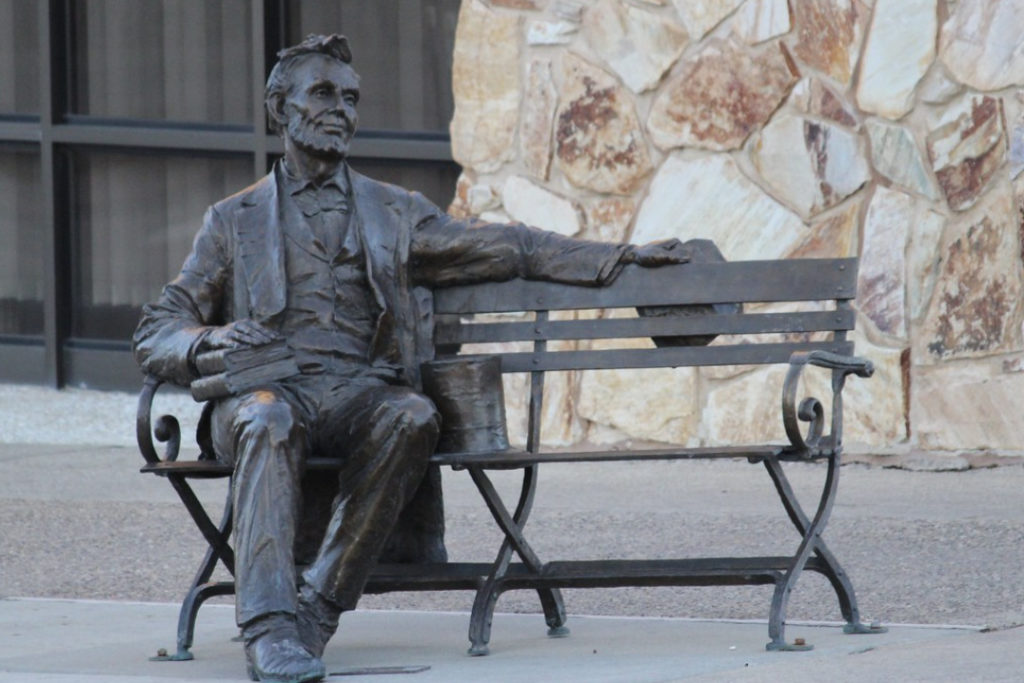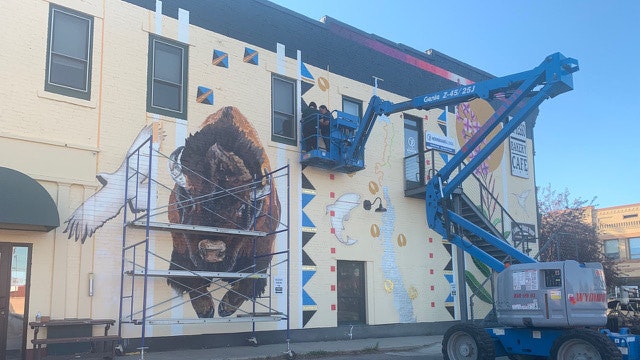By Joshua Wood, tourism/business reporter
josh@cowboystatedaily.com
Measuring the direct economic benefits of public art can be difficult. For those who support these programs, the indirect benefits are worth the cost.
Instilling pride in the community is one of the biggest investments, said Laura McDermit, director of the Laramie Public Art Coalition.
The organization is supported through a combination of public funds like 5th Penny Sales Tax revenue from the City of Laramie and Albany County and private donors.
“It really is an investment in the community and the people who live there,” said McDermit. “Their pride of place, their excitement and livability of a place translates to somebody wanting to come visit here.”
Community Pride
A common theme among the communities and organizations supporting public art programs is the sense of community pride the programs encourage.
“One of the best examples is our city administrator,” said Kim Love, owner of Sheridan Media. “When he was considering locating here, he was impressed with the sculpture program and said that’s why he wanted to be in Sheridan. It made a statement, by the community, about how they felt about their community.”
Sheridan’s public art committee was formed in 2001 by then-mayor Jim Wilson. In Gillette, a similar program, the Mayor’s Art Council, was formed in 2003. Because of both programs, each city has more than 120 bronze sculptures lining the streets.
Each year, up to eight sculptures are loaned to the permanent collection for 12 months. The two cities each use a similar program that pays artists an honorarium or stipend to borrow their sculpture, during which time the piece is available for purchase by the public.
After each year, at least one sculpture is purchased by the city for the collection through fundraising from private donors. In Gillette, more than 100 sculptures have been sold in the past 15 years through this program.


“People that are visitors in Gillette are amazed at how many pieces of art we have in and around Campbell County that are part of the Mayor’s Art Council,” said Stephanie Murray, Community Engagement Manager for Visit Gillette. “They’re amazed at how many people actually donate the art back to the city to be saved here and for people to enjoy.”
Community pride through investment in public art is the only reason McDermit, who is originally from Pittsburgh, and her husband moved to Laramie.
“We needed to be in a space that was excited about artwork and having new and interesting things happen,” said McDermit. “We definitely saw that in Laramie.”
According to Stacy Crimmins, studies show that arts and culture are among the top reasons someone moves to a community. Crimmins, along with being a member of the Platte Valley Arts Council and project coordinator of the Platte Valley Public Art Project, is a former CEO of the Saratoga/Platte Valley Chamber of Commerce.
“We’ve been told by more than one person when they were evaluating communities to move to, that (public art) was a deciding factor,” said Crimmins. “I heard that quite a bit at the chamber of commerce.”


Economic Development
While the success of tourist attractions and events can be measured through lodging demand and sales taxes, public art is more difficult to track through traditional means.
“It’s hard to specifically measure the dollar amount in terms of added dollars to a community that public art brings in, but it definitely is a draw for tourists,” said Rachel Clifton, assistant director of the Wyoming Arts Council, who lives in Laramie.
Downtown Laramie is awash with colorful murals from a variety of artists. These murals, said Clifton, encourage travelers to stop and explore the community.
“This leads to spending dollars to go shopping or have lunch,” said Clifton.
Love believes the public art program has had a positive effect on tourism in Sheridan. While bronze sculptures are purchased with the help of private donations, the City of Sheridan supports the program through operational expenses.
“It’s kind of hard to measure because we’re not like a museum where you can count the people that come through the front door but just look at the number of people who are posing with sculptures and stopping to admire them,” said Love.
Because that money can be hard to trace back to public art, it can make applying for grants to support public art difficult as well. So, project coordinators sometimes have to be creative.
Such is the case with the Bossert Collective in Lander when they applied for Fremont County’s MOVE (Making Opportunity for a Viable Economy) grant. All projects supported by the Bossert Collective are grant funded.
“The way I wrote that grant and the way I pitched it to the commissioners was when people see public art they stop,” said Stacy Stebner, project coordinator and co-founder of the Bossert Collective. “I can’t guarantee that because we put a giant mural on the wall that every business is going to see a $10,000 increase every year. It’s really difficult to quantify the exact impact.”
Without hard numbers, Stebner looked to other towns in the West which had invested in public art such as Taos, New Mexico and Lakewood, Colorado.
“It’s absolutely transformed these downtown spaces,” said Stebner. “There’s more people stopping, there’s more businesses that are able to stay, there’s more businesses moving in, there’s fewer empty storefronts and they’re attributing it to this investment in public art.”
Support Your Local Artist
One economic aspect of public art most people may not think about, said Clifton, is how it benefits local artists. It’s one of the reasons she supports more funding for public art programs.
“I’m always a strong supporter of more funding for public art. I think it’s a great way for communities to invest financially and culturally in their communities and support their local artists,” said Clifton. “You’re paying the people who live and work in that community a living wage to help beautify and enhance their community.”
Supporting local artists is exactly what the Platte Valley Arts Council is doing with its public art project using six local artists, though that may not have been the original intention.
“The way we structured this was to try and fit a very small board and make sure we could handle what we were doing,” said Crimmins. “We chose them (the artists) based on the fact we knew their work.”
One of the artists is the late Jerry Palen, creator of the syndicated “Stampede” one-panel comic. An oversized comic panel will be Palen’s contribution to the project. Another artist, Jamie Waugh, will be creating an homage to the late cowboy poet Chuck Larsen.
Representing the Underrepresented
Public art advocates say supporting local artists also means giving a platform and a voice to a demographic which may feel underrepresented in their community. This is the case with the Bossert Collective and its current project with two recipients of the Wyoming Arts Council’s Native Art Fellowship.
Colleen Friday, who is Northern Arapaho, and Talysa Abeyta, who is Eastern Shoshone, are painting a mural on the side of the Lander Bake Shop with the help of another artist, Adrienne Vetter. Friday has contributed to murals for the Laramie Public Art Coalition and is combining her artistic style with Abeyta’s for the mural in Lander.
Friday has a Masters Degree in Rangeland Ecology which has found its way into the mural via a painting of a fireweed, one of the first plants to grow following a wildfire. Abeyta has a background in ledger art, which places modern images on historic ledger paper.
“They designed the mural to look like one giant piece of ledger art, combining both of their elements,” said Stebner. “So it has the fireweed and then Talysa’s image is this really huge buffalo that’s sort of running at you from the wall.”
The mural being painted by Friday and Abeyta are quite different from the bronzes seen in Lander. Stebner said there was a reason for that.
“We have this great little community that borders the Wind River Indian Reservation, a community of 50,000 Native American people, and it’s really not represented at all here in Lander,” said Stebner. “Driving through Lander, you’d have no idea that the Eastern Shoshone and Northern Arapaho tribes are right there.”
Friday and Abeyta’s mural is an example of how public art can be used to make a statement, said Clifton.
“Lander, in particular, and other communities really look to public art as a way to not only hire Native artists and people of color but also have that artwork then directly reflect their lived experiences,” said Clifton. “It really does give a voice to the artist and the people living in that community.”
Art for Everybody
According to Crimmins, an important feature of public art is its accessibility.
“That means that families can access the art without having any barriers. In Saratoga and Encampment, we have an underserved population,” said Crimmins. “There aren’t a whole lot of arts and cultural opportunities here, so that’s why the (Platte Valley) arts council exists is to try and bring those opportunities.”
Removing barriers for more random encounters with art makes those experiences more special, said Clifton.
“It helps soften the edges a little bit and can help create encounters with art on people’s own terms,” said Clifton.
There may still be some barriers between members of the public and public art, said Stegner, based on its location in business and shopping districts.
“We kind of like to think of it as being for everyone and it is because it’s public but it’s also been placed in a specific area to generate business dollars,” said Stebner. “Not everybody in our community has the capacity to stop in these places and to spend money in these places.”
Stebner said it is important to look beyond the economic benefit public art can have for a community.
“It’s also providing some visual stimulation and something really beautiful to look at, even if people aren’t going to stop and it isn’t going to have an economic impact,” said Stebner. “It still contributes to a quality of life.”





